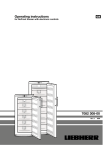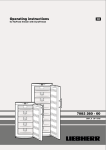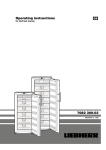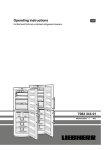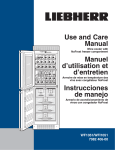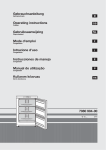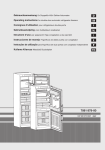Download Liebherr IGS 1113 freezer
Transcript
Operating instructions
GB
for built-in refrigerators
7082 544-00
IG/EG 3/1er
4706
The appliance at a glance
Operating and control elements, fig. A1
1 On/Off and temperature control
2 SuperFrost button, lit = function activated.
3 Green light/operational display,
with °C scale = freezer temperature setting display*
4 Audible warning on/off button,
with visual warning light: temperature too high
Type/Data plate, fig. A2
1 Type designation
2 Service No.
3 Serial No.
4 Freezing capacity in kg/24 hours
Description of appliance and equipment
Fig. A
1 Operating and control elements
2 Cold-storage accumulator*
3 Freezer tray*
4 Drawers with information system*
5 VarioSpace thanks to removable intervening shelves*
6 Type plate
8
* Depending on model and options
IG/EG 3/1
Keep these operating instructions in a safe place and pass them
on to the next owner, where applicable.
The operating instructions apply to several models. Differences
may therefore occur.
Contents
Page
Safety instructions and warnings
Disposal notes
The packaging is made of recyclable materials.
- Corrugated board/board
- EPS moulded parts
- Polythene sheets
- Polypropylene straps
W Keep packaging materials away from children polythene sheets and bags can cause suffocation!
W Please return the packaging to an official collection point.
Operating instructions
The appliance at a glance ......................................... 8
Contents ................................................................... 9
Safety regulations ..................................................... 9
Notes on energy saving............................................. 9
Safety instructions and warnings .................................... 9
Disposal notes .......................................................... 9
Setting up ................................................................ 10
Connecting to the mains ......................................... 10
Operation and control elements .................................... 10
Switching the appliance on and off .......................... 10
Setting the temperature ........................................... 10
Temperature display ................................................ 10
Audible warning signal ............................................ 10
SuperFrost .................................................................... 11
Notes on freezing and storage ............................... 11
Equipment .................................................................... 12
Information system .................................................. 12
Freezer tray ............................................................. 12
Cold-storage accumulators ..................................... 12
VarioSpace* ............................................................ 12
Cleaning ....................................................................... 12
Troubleshooting ............................................................ 13
Customer service and type plate ............................. 13
Your old appliance: This contains some reusable materials
and should be disposed of properly - not simply with unsorted
household refuse.
W Discarded appliances should be disabled: Remove
the plug, cut through the connection cable and
render the catch unusable so that children cannot
become trapped inside.
W Ensure that the refrigerant circuit is not damaged
when the appliance that is no longer needed is taken
away for disposal.
W Details of the refrigerant can be found on the type plate.
W Appliances which are no longer needed must be disposed of
in a professional and appropriate way, in accordance with the
current local regulations and laws.
Technical safety
W To prevent injury or damage to the unit, the appliance
W
W
Safety regulations
W The appliance is designed to freeze and store food and
§
to make ice. It is designed as a household appliance. We
cannot guarantee that the appliance will work properly if it is
used for another purpose.
W The appliance is set to operate within specific ambient
temperature limits according to its climate rating. These
temperature limits should not be exceeded. The correct climate
rating for your appliance is indicated on the type plate. This is
explained as follows:
Climate rating
for ambient temperature
ST
up to +38 °C
SN, N
T
up to +32 °C
- The appliance will function properly in ambient temperatures
of down to +5°C.
- The refrigerant circuit has been tested for leaks.
- When installed, this appliance corresponds to the relevant
safety provisions and EC directives 2006/95/EC and 2004/108/
EC.
W Ensure that there is adequate space around the appliance
W
W
W
W
W
W
!
for ventilation and air extraction.
Avoid keeping the door open for too long.
Store food logically. Do not exceed the storage period
specified.
Keep all food properly packed and covered so as to avoid its
frosting up on the outside.
Always allow hot food to cool to room temperature before placing
in the appliance.
Defrost frozen food in the refrigerator.
Keep the appliance door shut in the event of a breakdown. This
will delay the cold loss and will help to maintain the quality of
the frozen food for longer.
IG/EG 3/1
W
W
W
W
should only be transported wrapped and set up by
two people.
The refrigerant R 600a is environmentally friendly but
flammable.
Do not damage the refrigerant circuit pipes. Splashes of
refrigerant can harm your eyes or ignite.
If refrigerant escapes, remove all naked flames or sources of
ignition in the vicinity of the leak, disconnect the appliance from
the mains and ventilate the area well.
In the event that the appliance is damaged, contact the supplier
immediately before connecting to the mains.
To guarantee safe operation, ensure that the appliance is set up
and connected as described in these operating instructions.
Disconnect the appliance from the mains if any fault occurs.
Pull out the plug (not by pulling on the mains cable) or switch
off or remove the fuse.
W Any repairs and work on the appliance should only
be carried out by the customer service department,
as unauthorised work could prove highly dangerous
for the user. The same applies to changing the mains power
cable.
up to + 43 °C
Notes on energy saving
GB
Safety during use
W Do not store explosives or sprays using combustible
W
W
W
W
W
propellants such as butane, propane, pentane, etc.
in the appliance. Electrical components might cause
leaking gas to ignite. You can identify such sprays by
the printed contents or a flame symbol.
Only store high-percentage alcohol in tightly sealed, upright
containers.
Do not allow naked flames or ignition sources to enter the
appliance.
Do not use electrical appliances inside the appliance (e.g. steam
cleaners, heaters, ice makers, etc.).
Do not stand on the plinth, drawers or doors or use them to
support anything else.
This appliance is not intended for use by persons (including
children) with reduced physical, sensory or mental capabilities
or lack of experience and knowledge unless they have been
given initial supervision or instruction concerning use of the
appliance by a person responsible for their safety. Children
should be supervised to ensure that they do not play with the
appliance.
* Depending on model and options
9
W Avoid prolonged skin contact with cold surfaces or chilled/frozen
food. This could cause pain, numbness and frostbite. In the
case of prolonged skin contact, protective measures should
be taken, e.g. gloves should be worn.
W Do not eat ice-cream, particularly ice lollies or ice-cubes,
immediately after taking them from the freezer compartment as there is a risk of "burning" because of the very cold
temperatures.
W Do not consume food which has been stored for too long, as
it could cause food poisoning.
Operation and control elements
Installation and ventilation information
W When setting up/fitting ensure that the refrigerant circuit pipes
are not damaged.
W Avoid positioning in direct sunlight or next to an
oven, radiator or similar.
W Do not block the ventilation areas. Always
ensure that there is good ventilation and that
the outward flowing air is able to escape!
W Standard EN 378 specifies that the room in which
you install your appliance must have a volume of
1 m3 per 8 g of R 600a refrigerant used in the appliance, so
as to avoid the formation of inflammable gas/air mixtures
in the room where the appliance is located in the event of a
leak in the refrigerant circuit. The quantity of refrigerant used
in your appliance is indicated on the type plate on the inside
of the appliance.
W Fit the refrigerator/freezer in stable kitchen units only.
W Please follow the enclosed installation instructions.
W Remove all transportation safety components.
Connecting to the mains
Power supply (AC) and voltage
at the operating point must comply with the details on
the type plate, which is located inside the appliance on
the left, fig. A.
W Connect the appliance with a properly earthed
fused plug and socket only.
W The socket must be fused with a 10 A fuse or higher, it must
be away from the rear of the appliance and must be easily
accessible.
W Do not
- connect to stand-alone inverters,
- operate with so-called energy-saving plugs - this can damage
the electronic system.
- connect to the supply with other equipment using an extension
cable - risk of overheating.
W When removing the mains cable from the back of the appliance,
remove the cable holder to prevent vibration noise.
Switching the appliance on and off, fig. A1
W Switching on: Turn the temperature control 1 with a coin so
that the slot is pointing to setting 2.
- A green light on the display 3 will light up and indicate that
the appliance is in normal mode.
- The red visual warning light will be on until the freezer has
reached a sufficiently low tempera-ture, then it goes out. See
"Audible warning signal, red visual warning light" for more
information.
W Switching off: Set the temperature control to "0" .
- The temperature display and all buttons will go out.
Setting the temperature, fig. A1
W Turn the temperature control 1 with a coin:
- until the display 3 next to the temperature range wanted
(-18 °C)* is illuminated, or
- turn the slot of the temperature control to setting 3,
fig. A1. The setting of the slot significy.
Setting 1
= lowest cooling setting
lowest cooling setting
Setting "max." = lowest temperature,
highest cooling setting
W Recommended temperature setting: -18 °C or control
setting 3.
Temperature setting display*, fig. A1/3
- When the temperature display is illuminated, this indicates that
the appliance is running.
- The five blocks in the display each relate to a different
temperature range.They indicate the freezer temperature setting
you have selected.
- Within the temperature / setting range, e.g. when the display
reads -15 °C to -18 °C, or between two settings*, the temperature
can be set slightly colder. If required, slowly turn the temperature
control 1 further - the light displaying the temperature range,
e.g. -18 °C, flashes for a short time. This confirms the higher
setting within the small temperature range.
Audible warning signal*, red visual warning light,
fig. A1
The audible warning signal and the red visual warning light are
designed to help you to protect your frozen food and to save
energy.
W The audible warning device is switched off by pressing
the audible warning button 4 or
- It switches off automatically as soon as the temperature is low
enough.
- It always sounds if the freezer temperature is not low enough
(dependent on the temperature setting).
10
* Depending on model and options
IG/EG 3/1
- The red visual warning light will flash simultaneously.
This can be caused by:
- warm, fresh food being placed in the freezer,
- too much warm air from the outside entering when re-arranging
or removing frozen food. These temperature fluctuations will
not affect the quality of the frozen food.
- When the audible warning on/off button is pressed, the visual
warning light will stop flashing and will light up continuously. It
will only go out once the alarm status stops and the temperature
inside the freezer is low enough. The audible warning signal is
now automatically reset.
W If the SuperFrost button flashes at the same time as
one of the lights on the temperature display, this means that
your appliance has a fault. Contact your customer service
department and tell them that this visual warning is active,
so that they can arrange for your appliance to be serviced
accurately and quickly.
Notes on freezing and storage
W Items suitable for freezing: meat, game, poultry, fresh
W
W
W
W
-
W
SuperFrost, notes on freezing and
storage
SuperFrost, Fig. A1
Fresh food should be frozen to the core as rapidly as possible.
Frozen food can also be given a cold boost. This is provided by
the SuperFrost facility and ensures that the nutritional value,
appearance and flavour of the food remain intact.
W The maximum amount of food which can be frozen in 24 hours
is shown on the type plate ("Freezing capacity... kg/24h", fig.
A2, pos. 4. This amount varies according to the model and
climate rating.
Freezing with SuperFrost
W Briefly press the SuperFrost button
2 so that it is
illuminated - at the same time the coldest set value
of the temperature display is illuminated.
The freezer temperature will decrease and the
appliance will switch to the lowest temperature.
W For small amounts of frozen food, it is normally sufficient to
switch on SuperFrost 6 hours beforehand. For the maximum
amount (see freezing capacity on the type plate) you will need
to switch it on 24 hours beforehand.
W Then place the fresh food inside the freezer, preferably in the
lower drawers.
For the maximum amount, freeze the packed food without
drawers. Place it straight onto the shelves and, once frozen,
put it in the drawers!
- SuperFrost switches off automatically after about 65 hours.
The freezing operation is concluded - the SuperFrost button
is dark, the set temperature value is again illuminated - the
appliance resumes the normal energy-saving mode.
W
W
fish, vegetables, fruit, dairy products, bread, baked goods,
pre-cooked meals. Not suitable: lettuce, radishes, grapes,
whole apples and pears, fatty meat.
Pack frozen food in standard freezer bags or reusable plastic, GB
metal or aluminium containers.
Do not allow fresh food which is to be frozen to come into
contact with food already frozen. Always keep packs dry in
order to avoid them sticking together.
Always write the date and contents on the pack and do not
exceed the stated storage time for the food. This prevents any
risk of quality impairment.
Pack food which you are freezing yourself in quantities
appropriate to your household. To ensure that the food freezes
right through quickly, the following quantities should not be
exceeded per package:
fruit, vegetables: up to 1 kg;
meat: up to 2.5 kg.
Blanch vegetables after washing and cutting them. (Add to
boiling water for 2-3 minutes, remove and quickly cool down
in cold water. If you blanch with a steamer or microwave oven,
please observe the relevant operating instructions.)
Do not salt or season fresh food or blanched vegetables before
freezing. Only lightly salt and season other food. Some spices
can alter their flavour intensity.
Do not freeze bottles and cans which contain carbonated drinks
as they might burst. Drinks can be cooled down quickly, but
take the bottles out of the freezer compartment after an hour
at the most.
W Storage: Each drawer and shelf can take up to 25 kg frozen
food.
W If you want to use the maximum net capacity, you can remove
all the drawers and shelves (please refer to the "VarioSpace"
section for removal).
W Always store identical food items together to avoid the door being
open for unnecessarily long periods and to save energy.
W Do not exceed storage times given.
W Thawing : Only take out as much food as is immediately required
for thawing. Cook food which has been thawed as quickly as
possible.
Frozen food can be thawed in the following ways:
-
in a conventional or fan oven
in a microwave oven
at room temperature
in the refrigerator: the cold given off by the frozen food is used
for cooling the other food.
- Flat portions of meat or fish can be cooked when partially
thawed.
- Vegetables can be cooked from frozen (in half the normal
time).
Note: When the SuperFrost function is activated the appliance
will be running at full capacity, so the refrigeration unit will
sound slightly louder for a while.
You should not switch on the SuperFrost function:
- when placing frozen food in the freezer;
- when freezing up to approx. 2 kg fresh food daily.
IG/EG 3/1
* Depending on model and options
11
Equipment
VarioSpace*
Information system*
pre-cooked meals
ice-cream
fish
pork
vegetables
fruit
sausages
bread
mushrooms
game
poultry
beef/veal
Use frozen food within the recommended period.
The numbers between the symbols indicate the storage period in
months for different kinds of frozen foods.
Storage times given are guide times for food frozen at home.
Whether or not the lower or upper value is applicable depends on
the food quality and how it was processed prior to freezing. The
lower values always apply to food with a high fat content.
- You can create a double-height space for big items of frozen
food by removing a drawer and a shelf.This enables you to freeze
such things as poultry or big pieces of meat without having to
cut them up first, so they can be served "whole" afterwards, and
to store other large items such as big gateaux or packs of ice.
- Depending on how much space you need, you can remove
1, 2, or all the drawers and shelves to use the entire interior.
Please note however that the maximum load of a shelf is 25 kg.
- Removing the drawer: Pull forward until the drawer stops
and lift out.
- Removing the shelf:
Lift up at the front and
pull out.
- To insert: simply push
shelf in as far as it will
go.
Freezer tray*
This is used for gently freezing
berries, herbs, vegetables
and other small items and
prevents them from sticking
together. Items being frozen
will largely retain their shape,
and it will be easier to remove exactly the right quantity
later on.
W Spread the items out
loosely on the tray.
W Freeze for 10 to 12 hours, then transfer to a freezer bag or
container and put in a drawer.
W To defrost, spread the frozen items out loosely.
Cold-storage accumulators*
These prevent the temperature in the freezer from rising too
quickly in the event of a power failure, thus preserving the
quality of the food.
You can freeze and store the cold-storage accumulators either in
the freezer tray or in the ceiling of the freezer compartment*.
W Inserting cold-storage
accumulators:
Remove the top drawer. Slide
the cold-storage accumulator
to the top back of the freezer
compartment ceiling and snap
it into place at the front.
W Removing cold-storage
accumulators:
Remove the top drawer. Take
hold of the cold-storage
accumulator at the side and
press it down for removal.
12
Cleaning
Notes on defrosting
After the appliance has been in operation for a lengthy period, a
layer of frost or ice will form in the freezer compartment, depending
on how often the door is opened and warm food is placed inside.
This is completely normal.
However, a thick layer of ice will increase the appliance‘s energy consumption. You should therefore defrost the appliance
regularly:
W Switch on SuperFrost one day before defrosting. The frozen
goods are provided with a "cold reserve".
W Thawing:Remove the plug or set the temperature control to
"0".
W If possible, put the frozen goods in the freezer drawer, wrap in
newspaper or a blanket and store in a cool place.
W To speed up the defrosting process put a saucepan of hot but
not boiling water on one of the shelves.
Do not use electric heaters or steam cleaners, defrosting
sprays or naked flames for defrosting nor any metal objects
for removing the ice. Risk of injury and damage!
W Leave the door of the appliance open while defrosting.
Soak up residual defrost water with a cloth. Then clean the
appliance and wipe dry
Cleaning
W Always disable the appliance for cleaning.
Disconnect from the mains or unscrew or
switch off the fuse.
W Clean the outer walls, inside and equipment by hand
with lukewarm water and a little detergent. Because
of the risk of injury and damage to the appliance,
steam cleaning equipment should not be used.
W We recommend using a soft cloth and an all-purpose cleaner
with a neutral pH value. Only use food compatible cleaning and
care agents on the inside of the appliance.
W Do not use abrasive sponges or scourers, do not use
concentrated cleaning agents and never use cleaning agents
containing sand, chloride or acid or chemical solvents, as these
would damage the surfaces and could cause corrosion.
* Depending on model and options
IG/EG 3/1
W Ensure that no cleaning water is allowed to penetrate into
the electrical components or ventilation grilles. Dry the
appliance.
- Do not damage or remove the type plate on the inside of the
appliance as this is important for customer service.
W Then connect/switch on the appliance, switch on SuperFrost
and start to insert the food to be frozen as the temperature
drops.
If the appliance is to be left switched off for any length of time
empty the appliance, disconnect from the mains, clean as described
above and leave the door open so as to avoid odours.
Troubleshooting
Your appliance is designed and manufactured for a long life span
and reliable operation.
If a malfunction nonetheless occurs during operation, check
whether it is due to an operating error. Please note that during
the warranty period the resultant servicing costs in this case will
have to be borne by the owner.
You may be able to rectify the following faults by checking the
possible causes yourself:
Malfunction
- Possible cause and remedy
Customer service and type plate
If none of the above causes apply and you cannot
rectify the fault yourself, or if the temperature display
reads "F 0" to "F 5", this means that there is a fault.
Please contact your nearest customer service department (see GB
enclosed list for addresses), indicating the warning displayed,
together with the
type designation 1
serial No.
service No. 2,
3
of the type plate. This will
help us to provide you with
a faster and more accurate
service. The type plate is
located inside the appliance
on the left-hand side.
Leave the appliance shut
until the customer service
engineer arrives so as to
prevent any further cold
loss.
Appliance does not work, the display is off
- Is the appliance switched on properly?
- Is the mains plug properly inserted in the socket?
- Is the socket fuse intact?
Loud running noise
- Is the appliance standing firmly on the floor, or does the
compressor cause nearby items of furniture or objects to
vibrate?
If necessary, move the appliance slightly, align by adjusting the
adjustable feet, or move bottles and containers apart.
- Burbling noises are normal. These are caused by the
refrigerant flowing round the refrigerant circuit.
A short clicking sound: This will be heard whenever the
refrigeration unit (the motor) switches on or off automatically.
Motor noise: This will be slightly louder for a brief period when
the refrigeration unit switches on. The refrigerating capacity will
increase when the SuperFrost function is activated, fresh food
has just been placed in the appliance or the door has been left
open for a while.
The audible warning signal sounds, the temperature is
not cold enough
- Have you put too much fresh food into the freezer without
activating SuperFrost? (See "SuperFrost")
- Does the door close properly?
- Is the appliance sufficiently well ventilated?
Clear ventilation grilles if necessary.
- Is the ambient temperature too hot?
(See "Safety regulations")
- Has the appliance been opened too often or left open too
long?
- If applicable, wait until the appliance reaches the required
temperature itself.
IG/EG 3/1
_______________________________________________________
The manufacturer works constantly on the further development of all the
types and models. Therefore please understand that we have to reserve
the right to make design, equipment and technical modifications.
* Depending on model and options
13







